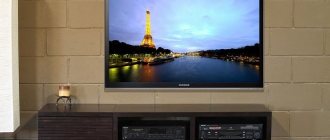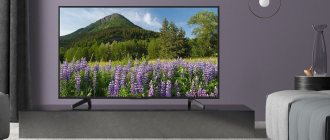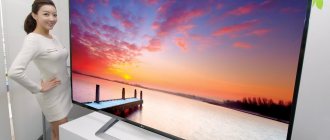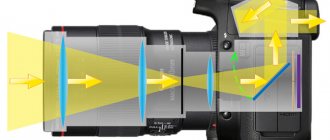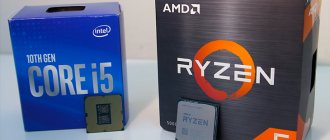Despite the fact that LG TVs occupy more than half of the European market, to this day many experts argue about which brand is the leader. Given our significant experience in compiling selections, testing relevant equipment and studying information from colleagues, we also want to share our opinion on which TV is better to choose in 2021 - from LG or Samsung. To do this, we propose to compare different classes of products, as well as discuss the key differences between the technologies of these two South Korean manufacturers.
- Top 10 Samsung TVs;
- Top 10 LG TVs.
Comparison of Samsung and LG technologies
When comparing Samsung and LG TVs, I would like to start with the fact that they run on different operating systems, they have different processors and screen technologies, if we are talking about the premium sector. The first parameter, in our opinion, is less significant:
- Samsung uses the Tizen operating system;
- LG uses its proprietary WebOS operating system.
Today there are virtually no fundamental differences between them.
Both brands have a simple menu, many different hosting options, popular applications, etc. are available. With pre-installed software for both brands, everything is not ideal: it is difficult to remove anything, as is installing illegal software. In this regard, Android is more interesting.
In terms of control, each of them has voice control, cool remote controls, etc.
OLED vs QLED
This year it became known that LG will supply its OLED panels to Samsung. This was very difficult to predict 4-5 years ago, when this brand announced the presentation of a radically new, “innovative technology” - QLED. At that time, it seemed that the South Korean manufacturer had managed to carry out a revolution. Immediately, many fans of the brand were interested in the deep black color, for which the company has no competitors to this day. Later it became clear that other fundamental differences were worse rather than better. In particular, OLED panels based on organic light-emitting diodes shine brighter in the daytime, they are more economical and thinner.
In its justification, Samsung said that their technology is not yet fully developed. Many years have passed, and today many experts believe that QLED technology is closer to the parameters of a premium VA matrix, but with a very high price due to the marketing component.
In turn, LG has improved the IPS matrix by releasing a whole line of NanoCell TVs with a more objective price and excellent parameters: color rendering, brightness, viewing angle.
Comparison of Samsung and LG processors
Today, a lot depends not only on screen technology, but also on hardware, because modern TV models have high resolution, large sizes and powerful speaker systems. At the same time, premium TVs from LG and Samsung receive top-end processors, in which they show strong competition with each other. In fact, these brands are currently head and shoulders above their closest competitors, including the once popular Sony solutions with their amazing factory calibration. And so, let’s look at the key features of the companies’ chips that they use in the premium TV segment:
- Samsung equips its new products with a Neo Quantum 4K chip - they guarantee the fastest possible response, upscaling (picture scaling), up to 4K, complete immersion in what is happening on the TV;
- LG equips the latest collections with the α7 Gen3 chip - they are not inferior to the competitor in terms of upscaling, sound control, and stage dynamics.
Overall, these processors are very similar. Each of the chips has AI and can adapt to the specific type of content that the user is watching. This creates complete immersion in the atmosphere of either an action film, a sports program, etc.
Which TV is better - Samsung or LG?
Both LG and Samsung have LED displays in most of their low- and mid-priced TVs. Now this is a kind of standard that ensures decent quality of the generated image.
When it comes to high shelves, we can choose between two technologies. In the case of Samsung, we are talking about so-called quantum dots, that is, QLED technology. Thanks to small crystals between the color filters and the backlight, it is possible to adjust the wavelength, allowing a much wider range of colors to be obtained. The picture looks more realistic.
LG offers OLED TVs. This technology is based on LEDs, which do not need to be illuminated because they emit light themselves. This gives an almost perfect black color.
LG and Samsung TVs are offered in versions that support HD, Full HD and 4K resolutions.
Both Samsung and LG offer TVs with all the most important inputs, i.e. HDMI, USB and possibly VGA. However, it is always worth checking their quantity.
A separate topic is all kinds of technologies that improve sound and image. If we intend to use the TV to support streaming services or to play games on a console, we should focus on HDR models - a wide tonal range will ensure greater realism in the generated colors. The image will become brighter and its quality will improve significantly.
| Characteristics | Samsung UE55TU8000U | OLED LG OLED55C8 |
Permission | 3840×2160 | 3840×2160 |
| Matrix type | V.A. | V.A. |
| Update frequency | 60 Hz | 100 Hz |
| Smart TV platform | Tizen | webOS |
| Year of creation | 2020 | 2018 |
| Sound power | 20 W | 40 W |
| Inputs | AV, HDMI x3, USB x2, Ethernet (RJ-45), Bluetooth, Wi-Fi 802.11ac, Miracast | HDMI x4, USB x3, Ethernet (RJ-45), Bluetooth, Wi-Fi 802.11ac, WiDi, Miracast |
| Price | 47,589 rubles | 112 500 |
Which TV is better to buy in the middle class?
Considering the price/quality ratio, NanoCell takes the lead here for the following reasons:
- peak brightness is higher than that of IPS matrices;
- the price/quality ratio is better than that of QLED matrices;
- there are several 4K lines that differ in price;
- Each model from 43 to 49 inches has good sound and a fresh processor.
We no longer analyze UHD lines of previous generations, because over the past couple of years each brand has released many worthy new products.
Comparison of LG and Samsung premium TVs
In this class we are talking about comparing LG OLED and Samsung QLED TVs. In 4K resolution, in our subjective opinion, LG has more interesting solutions with a more adequate price on OLED matrices.
However, their quality is difficult to distinguish in the size range from 49 to 65 inches. It is even more difficult to notice the fundamental difference between QLED and OLED technology when we talk about 8K resolution. The flagships of both brands have luxurious processors with AI, peak brightness, contrast, frame rates, they do not fade, and convey deep blacks.
LG and Samsung TVs: who is better in 2021?
Thus, there is no clear leader in all segments today. Of course, if you don’t know which TV manufacturer is better in 2021 between LG and Samsung, it’s worth considering that the products of the first brand are in better demand due to the excellent price/quality ratio and advanced organic LED technology. At the same time, Samsung has been intriguing with extraordinary solutions for many years, but it orders OLED panels from a competitor. However, QLED matrices really please with deeper blacks, response speed, and contrast. Now our conclusion regarding leaders in different sizes:
- TVs up to 32 inches - Samsung takes the lead with their The Frame line;
- TVs up to 43 inches - in our opinion, the leadership is held by LG NanoCell TVs produced in 2020-2021;
- from 49 to 50 inches – we believe that mid-level 4K TVs are better from LG on NanoCell matrices, and in the premium class QLED and OLED panels are virtually no different;
- TVs from 65 inches - it is difficult to determine the leadership and notice a significant difference between premium OLED and QLED TVs.
In the flagship class of 8K TVs larger than 80 inches, we were unable to find clear leaders. Each manufacturer sets the bar at a very high level.
Matrix type
The criterion that directly affects the quality of the picture is the type of matrix. It is interesting that in inexpensive models the type of matrix is usually not specified and in fact it is impossible to recognize the matrix. In most cases, this is a standard IPS matrix. If we move on to models with a larger size and price tag, then here we can see the own developments of LG and Samsung, which have been competing for many years. Sony is not far behind; the latter's matrices are considered the best in terms of natural color rendering.
LG's best matrix is an organic LED matrix. Without going into the details of the technology, the point is that the LEDs (pixels) illuminate themselves. Due to this, there is no loss of light, which ensures better brightness, natural color rendition, and long service life. If you compare a regular LED TV and an OLED TV, the difference in picture quality will be colossal.
Samsung and Sony are not lagging behind LG and also present their own versions of matrices based on organic LEDs; in stores, sellers can hear the term self-illuminating pixels, which means exactly the same thing. Interestingly, sellers often mistakenly say that LG’s OLED matrix and Samsung’s QLED are practically the same thing. But that's not true. LG's development, as mentioned above, is based on the fact that the pixel itself glows, that is, it is an LED. QLED uses quantum dots, but they do not glow; a separate backlight is required. Due to this, they are inferior in color gamut and do not have true black.
Thus, QLED is inferior to OLED, but at the same time their cost is lower. A good OLED TV can start at a price of 100 thousand, but a QLED in Samsung can have a price from 70 thousand rubles. Given that many buyers simply will not see the difference, it makes sense to opt for Samsung matrices. For those who are not ready to pay a lot for a TV, but want to buy a model with a good picture, it makes sense to take a closer look at the SUHD (Premium and Step-up UHD) models from Samsung. They use RGB subpixels, but operate according to different standards than QLED. Thus, SUHD is a transition from conventional LED TVs to QLED.
Sony's development, which is similarly based on organic LEDs, is called Triluminos Display. To put it simply, there is a filter that is installed between the matrix and the LEDs. Initially, the LEDs are painted blue, but due to a special filter they can change the final color. The technology is promising, similar to SUHD from Samsung. The difference is that Samsung TVs are brighter, while Sony TVs are much more natural.
To summarize the topic of matrices, it is worth noting that the final choice always remains with the user. All types have their merits, but it is best to run one video in the store on each TV with similar technologies and settle on the option that you like best.
Regarding the production of matrices. Buyers often ask which company made the matrix for this or that manufacturer. There is no answer to the question; if the seller names a brand, then most likely he is improvising. Representatives of TV production companies do not talk about where and from whom they purchase their components. In fact it doesn't matter.
Helpful advice - when watching TV in a store, you should ask the seller to set the same settings on each device being tested, for example, turn on the “cinema” or “bright” mode. This is done in order to understand the true image, because sellers are cunning and dim the “brightness” on those models that they do not need to sell.

